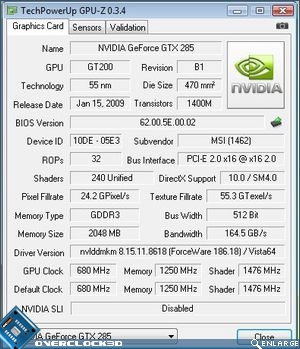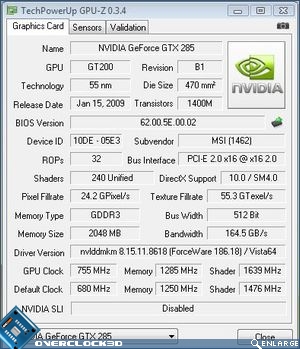Test Setup
To ensure that all reviews on Overclock3D are fair, consistent and unbiased, a standard set of hardware and software is used whenever possible during the comparative testing of two or more products. The configurations used in this review can be seen below:
Â
i7 Rig
CPU: Intel Nehalem i7 920 Skt1366 2.66GHz (@3.8 Ghz)
Motherboard: Gigabyte EX58-UD5
Memory: 3x2GB Corsair DDR3 1600mhz @ 8-8-8-24
HD : Hitachi Deskstar 7k160 7200rpm 80GB
GPU: MSI N285GTX Superpipe 2G
Graphics Drivers: Supplied by MSI
PSU: Gigabyte ODIN 1200w
Â
During the testing of the setups above, special care was taken to ensure that the BIOS settings used matched whenever possible. A fresh install of Windows Vista was also used before the benchmarking began, with a full defrag of the hard drive once all the drivers and software were installed, preventing any possible performance issues due to leftover drivers from the previous motherboard installations. For the 3DMark and gaming tests a single card configuration was used.
To guarantee a broad range of results, the following benchmark utilities were used:
Â
3D / Rendering Benchmarks
• 3DMark 05
• 3DMark 06
• 3DMark Vantage
3D Games
• Crysis
• Far Cry 2
• Oblivion
• Race drive: GRID
• Call of Duty IV
• Unreal Tournament III
Â
Power Consumption
Power consumption was measured at the socket using a plug-in mains power and energy monitor. Because of this, the readings below are of the total system, not just the GPU. Idle readings were taken after 5 minutes in Windows. Load readings were taken during a run of Furmark.
Â
Â
Despite only needing 2x6pin PCIe cables, the GTX285 is certainly a hungry beast. While not the most power consuming card on test it was only second to the dual GPU cards.
Â
Â
Temperatures
Temperatures were taken at the factory clocked speed during idle in Windows and after 10 minutes of running Furmark with settings maxed out (2560×1600 8xMSAA). Ambient temperatures were taken with a household thermometer. As we use an open test bench setup consideration should be given to the fact that the temperatures would likely increase further in a closed case environment.
Â
Â
Idle temps were quite good on the 285 but load temps rocketted. Unusually, the fans didn’t spin up much past there idle speeds. I did increase the fan speed manually which brought the temps down to a much more reasonable 68c on load but as all the cards above were tested with the fan set in automatic I can only go on the readings obtained in this configuration. IÂ would like to say that the 2GB of ram would have added to the GPU temps but as we saw previously, the cooler is not attached to the memory cooling plate so the fact that the card is a 2GB model is pretty much irrelevant.
Â
Â
Overclocking
Â
For our overclocking tests I used the RivaTuner utility which worked perfectly with our setup. To test stability I ran 3D Mark 06 and a few runs of Call of Duty 4.
Â
Â
Overclocking the GTX285 with Rivatuner was a relatively simple affair. I first clocked the card to the rather hopeful overclock I managed with a watercooled 285 I reviewed previously. At this speed the card performed flawlessly so I was intrigued to see just how much further I could take the card. I settled on a fine overclock of 755/1639/1285 (core/shader/memory) which is the best speed I have managed out of any GTX285 IÂ have reviewed thus far. This is even more amazing when you consider that this card is carrying an extra GB of memory which will usually hinder overclocks, not add to them!
Â
The results of this overclock can be seen below:
Â
Not a bad increase at all. The increase at high res, while at first glance appears small is pretty significant in that at this resolution, every frame counts and a good 10% increase in FPS is nothing to be scoffed at.
Â
After returning the card back to it’s stock speed I ran our standard set of GPU benchmarks…




